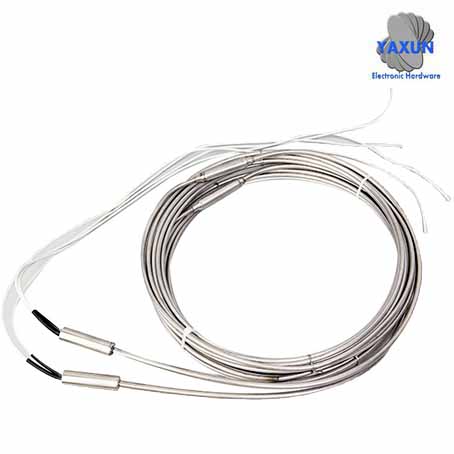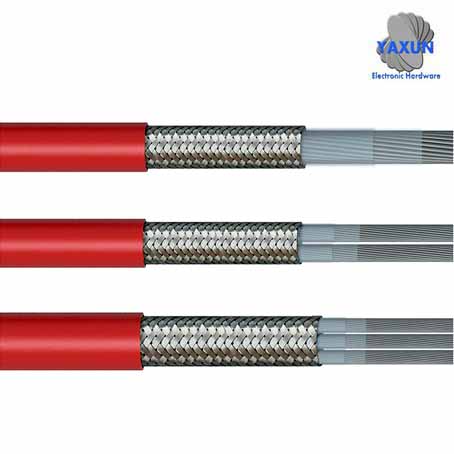Identify the Quality of Hheating Cables
The heating cable's core, PTC core tape, and PTC irradiation process affect the quality of the electric heating cable.

So how to distinguish the irradiation process of the electric heating cable?
First of all, we can observe the situation from the surface of the insulating layer of the electric heating cable; The insulation layer of an electric heating cable that has been irradiated as a whole has some hardness, while the insulation layer of an electric heating cable that only irradiates the core tape is relatively soft. Please pay attention to consumers! Secondly, in addition, the insulating layer of the entire irradiated electric heating cable cannot be moved back and forth (the electric heating belt whose insulating layer can be moved back and forth is not a high-quality electric heating belt). At the same time, when such an electric heating cable is energized and generates heat, the unirradiated insulating layer has greater shrinkage. Due to the shrinkage of the insulating layer, the semiconductor PTC core tape is exposed, which is prone to leakage and short circuit, which poses a great safety hazard.

▲ Anti-freeze cracking of industrial and civil water pipes in winter
▲ Insulation and heat tracing of liquid transportation pipelines in industrial and mining enterprises
▲ Insulation and heat tracing of enterprise steam pipeline
▲Insulation of compressed air and gas and natural gas pipelines in industrial and mining enterprises
▲ Winter antifreeze of urban fire protection system
▲ Insulation and heating of gas and liquid storage tanks in industrial and mining enterprises
▲ Winter anti-freezing of industrial and civil pipeline valves
▲ Winter heat preservation of special instruments
▲ Deicing and snow removal of important roads and places in winter

1, the core conductor of the heating cable
The electric heating cable is a long flat belt, and the quality of its conductive core wire is directly related to the quality of the heating cable. Usually the conductive core wire is tinned copper wire. The quality of the copper wire directly affects the insulation effect, of course, the quality of the conductor is checked by the manufacturer. How do consumers distinguish the quality of the conductor core? The conductor of the heating cable is generally formed by twisting 7 strands of tinned copper wire, and the amount of conductor used directly affects the cost price of the heating cable. In order to reduce costs, some manufacturers have reduced the cross-sectional area of copper. Based on the problems reported by customers for many years, a more reasonable design was made, which is to increase the conductor cross-section and use a 7*0.52 (1.5 square) core. Nowadays, competition in the cable industry is fierce. The mainstream cable core on the market is still a 7*0.43 (1.0 square) conductor. This kind of heating cable has a very serious drawback, that is, the starting current is too large. This is what will be mentioned below.2. Starting current of heating cable
The PTC core tape of the heating cable is the core part of the heating cable. It is difficult for general manufacturers to master its core technology. The key is the size of the starting current and the decay rate. The starting current refers to the current peak value generated instantaneously when the heating belt is connected to the power supply. It has a decisive significance for the quality of the heating belt, and it is a key parameter that reflects the technical level of the heating belt manufacturing. If the starting current is large, the length of the heating band of a single power supply will be reduced accordingly. At the same time, each time it is started, the electrical contact interface between the PTC layer and the conductive core will be destroyed, shorten the service life of the electric heating belt, and present a great safety hazard. The starting current of most manufacturers' products is generally around 0.6~1.2A/m, and the products of American Raychem Company are below 0.5A/m. The electric heating cable produced by our company through technological improvement, the starting current of the low-temperature electric heating belt can be controlled below 0.3A/m. The starting current of the medium-temperature electric heating belt can be controlled at about 0.3A/m, reaching the leading level of international technology. Therefore, all users and friends must understand the important technical parameter of starting current when purchasing electric heating belts. Friendly reminder from electric heating experts: When conditions permit, it is best to test it yourself, and try to buy products with lower starting current, so as not to cause unnecessary losses to yourself and the company.3. PTC irradiation process of electric heating tape
1. After the PTC core tape of the electric heating cable is made, it needs to be irradiated and cross-linked to have the optimal PTC effect. The quality of cross-linking determines the stability and service life of the core belt. More common is the use of high-energy electron irradiation cross-linking. Determine the appropriate radiation dose according to the PTC material system. In addition, the dose rate should not be too large, the linear velocity should also be uniform during irradiation, and the running tension and friction should be controlled. Some domestic manufacturers’ electric heating tapes have not been cross-linked by irradiation, so it seems that the manufacturers have saved costs for users, which poses a big safety hazard. The insulating layer that has not been cross-linked by irradiation is poor in terms of heat resistance and aging resistance. Over time, leakage, short circuit, and damage to the performance of the PTC core belt are likely to occur, which greatly shortens the service life of the heating tape. The electric heating cable tapes introduced by our company are cross-linked by radiation and have good heat resistance and aging resistance. During use, it not only prolongs the service life of the heating belt, but also improves its safety.So how to distinguish the irradiation process of the electric heating cable?
First of all, we can observe the situation from the surface of the insulating layer of the electric heating cable; The insulation layer of an electric heating cable that has been irradiated as a whole has some hardness, while the insulation layer of an electric heating cable that only irradiates the core tape is relatively soft. Please pay attention to consumers! Secondly, in addition, the insulating layer of the entire irradiated electric heating cable cannot be moved back and forth (the electric heating belt whose insulating layer can be moved back and forth is not a high-quality electric heating belt). At the same time, when such an electric heating cable is energized and generates heat, the unirradiated insulating layer has greater shrinkage. Due to the shrinkage of the insulating layer, the semiconductor PTC core tape is exposed, which is prone to leakage and short circuit, which poses a great safety hazard.

Application field of heating cable
Electric heating products can be widely used in: Heat tracing, antifreeze and anti-condensation for pipelines, pumps, valves, tanks and tank volumes in petroleum, chemical, electric power, medicine, machinery, food, shipping and other industries. It is the most advanced and effective method for maintaining the process temperature of liquid pipelines and liquid storage medium tanks. Electric heating is not only suitable for various places of steam heating, but also can solve the difficult problems of steam heating. Such as: heat tracing for long-distance pipelines, heat tracing in narrow spaces; heat tracing for equipment with irregular appearance (such as pumps); No steam heat source or heat tracing for pipelines and equipment in remote areas; Heat tracing of plastic and non-metallic pipes, etc. Examples of main applications are as follows:▲ Anti-freeze cracking of industrial and civil water pipes in winter
▲ Insulation and heat tracing of liquid transportation pipelines in industrial and mining enterprises
▲ Insulation and heat tracing of enterprise steam pipeline
▲Insulation of compressed air and gas and natural gas pipelines in industrial and mining enterprises
▲ Winter antifreeze of urban fire protection system
▲ Insulation and heating of gas and liquid storage tanks in industrial and mining enterprises
▲ Winter anti-freezing of industrial and civil pipeline valves
▲ Winter heat preservation of special instruments
▲ Deicing and snow removal of important roads and places in winter





